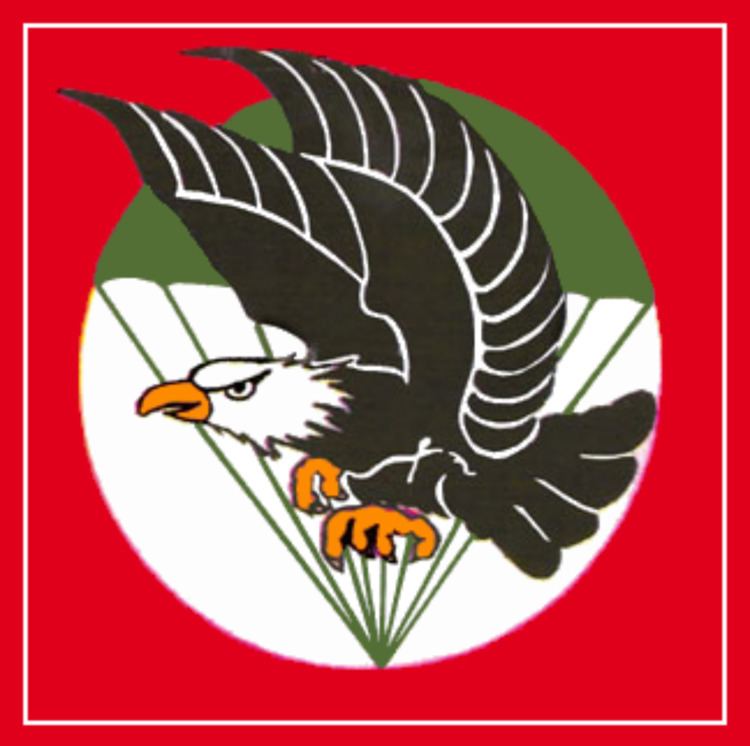The Vietnamese Airborne Division was one of the earliest components of the Republic of Vietnam Military Forces (Vietnamese: Quân lực Việt Nam Cộng hòa – QLVNCH). The Vietnamese Airborne Division began as companies organised in 1948, prior to any agreement over armed forces in Vietnam. After the partition of Vietnam, it became a part of the Army of the Republic of Vietnam.
Vietnamese Airborne Division was one of the most elite fighting forces in the ARVN. It was placed as a reserve unit along with the South Vietnamese Marine Division. Headquarters of the Airborne Division was outside of Saigon. The Airborne Division would mobilize anywhere within the four corps at a moments notice. The main use of the Airborne was to engage and destroy People's Army of Vietnam ('NVA') and Viet Cong forces, not hold a specific region like the infantry units.
Airborne brigade and divisional commanders
Đỗ Cao Trí (1954-1955)Nguyễn Văn VỹCao Văn Viên (1960-1964)Nguyễn KhánhDư Quốc ĐốngNguyễn Chánh Thi (1955-1960)Nguyễn Khoa NamĐoàn Văn QuảngLê Quang LưỡngLike all major ARVN units the Airborne were assigned a U.S. military advisory element, originally the Airborne Brigade Advisory Detachment and later redesignated the 162nd Airborne Advisory Detachment or U.S. Airborne Advisory Team 162. About 1,000 American airborne-qualified advisors served with the Brigade and Division, receiving on average two awards for valour per tour; over the years, they were able to build and maintain a good working relationship with their Vietnamese counterparts and airborne units, a situation unfortunately not always found in other ARVN formations. U.S. officers were paired with their Vietnamese counterparts, from the Brigade/Division commander down to company commanders, as well with principal staff officers at all levels. U.S. NCOs assisted the staff and company advisors.
Colonial units1st Indochinese Parachute Company (1ére CIP)3rd Indochinese Parachute Company (3e CIP)5th Indochinese Parachute Company (5e CIP)7th Indochinese Parachute Company (7e CIP)1st Airborne Guard Company (1ére CPGVN)3rd Vietnamese Parachute Battalion (3e BPVN)5th Vietnamese Parachute Battalion (5e BPVN)6th Vietnamese Parachute Battalion (6e BPVN)7th Vietnamese Parachute Battalion (7e BPVN)3rd Vietnamese Parachute Engineers Company (3ére CPGVN)Airborne Group unitsHeadquarters & Headquarters Company (HHC)1st Airborne Battalion (1 TDND)3rd Airborne Battalion (3 TDND)5th Airborne Battalion (5 TDND)6th Airborne Battalion (6 TDND)Airborne Combat Support BattalionAirborne Brigade unitsHeadquarters & Headquarters Company1st Task Force HQ1st Airborne Battalion (1 TDND)6th Airborne Battalion (6 TDND)7th Airborne Battalion (7 TDND)2nd Task Force HQ3rd Airborne Battalion (3 TDND)5th Airborne Battalion (5 TDND)8th Airborne Battalion (8 TDND)Airborne Combat Support BattalionAirborne Division unitsHeadquarters BattalionU.S. Airborne Advisory Team 1621st Task Force/Brigade HHC1st Airborne Battalion (1 TDND)8th Airborne Battalion (8 TDND)9th Airborne Battalion (9 TDND)1st Airborne Artillery Battalion2nd Task Force/Brigade HHC5th Airborne Battalion (5 TDND)7th Airborne Battalion (7 TDND)11th Airborne Battalion (11 TDND)2nd Airborne Artillery Battalion3rd Task Force/Brigade HHC2nd Airborne Battalion (2 TDND)3rd Airborne Battalion (3 TDND)6th Airborne Battalion (6 TDND)3rd Airborne Artillery Battalion4th Task Force/Brigade HHC4th Airborne Battalion (4 TDND)10th Airborne Battalion (10 TDND)Division TroopsAirborne Signal BattalionAirborne Support BattalionAirborne Medical BattalionAirborne Reconnaissance Company/BattalionAirborne Engineer Company/BattalionWeapons and equipment
The south Vietnamese airborne forces used the standard weaponry and equipment of French and U.S. origin issued to ANV and ARVN units. Paratrooper companies also fielded crew-served heavy weapons, such as mortars and recoilless rifles, whilst divisional artillery batteries were provided with Howitzers.
United States M1917 revolver United States Smith & Wesson Model 10 Revolver France MAS-35-S pistol (7.65mm Longue) United States Colt.45 M1911 Pistol United States Smith & Wesson Model 39 Pistol France MAT-49 Submachine gun United States M1A1 Thompson Submachine gun United States M3A1 Grease Gun Submachine gun United States M1/M2 Carbine United States M1 Garand rifle France MAS-36 Bolt-action rifle United States M16A1 Assault rifle United States CAR-15 Assault carbine France FM 24/29 Light machine gun United States M1918A2 BAR Light machine gun United States M60 machine gun United States Browning M1919A4/Mk 21 Medium machine gun United States Browning M2HB .50 Cal Heavy machine gun United States M72 LAW Anti-tank rocket launcher United States M79 Grenade launcher United States M2 mortar 60 mm United States M19 mortar 60 mm United States M29 mortar 81 mm France Brandt mle 27/31 mortar 81 mm United States M67 recoilless rifle 90 mm United States 3.5 inch M20A1 Super Bazooka Grenade launcher United States M101A1 105mm towed field howitzer United States M102 105mm light towed field howitzer
